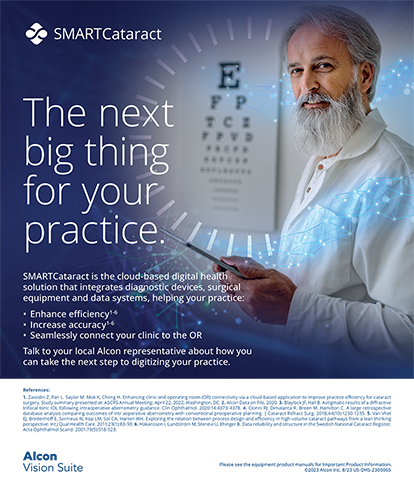In the past year, approximately 30% of my 2,200 cataract surgery cases have included the implantation of a premium IOL, predominantly the AcrySof Toric (Alcon Laboratories, Inc.) and the Tecnis Multifocal (Abbott Medical Optics Inc.). I was an early adopter of multifocal IOLs, because I saw how much patients desired uncorrected vision at all distances after cataract surgery. Without question, however, presbyopiacorrecting IOLs demand significantly more of the surgeon. The very high expectations that accompany a patient's decision to pay out of pocket for a refractive outcome mean that surgeons must strive for outcomes in cataract procedures approaching those of LASIK—a challenge indeed!
I have identified three keys to successful outcomes with multifocal IOLs: (1) increased surgical precision (2) astigmatic correction, and (3) individualized selection of the lens.
HIT THE TARGET
Using his Haigis formula optimization database of more than 200,000 IOL implantations submitted by ophthalmologists from all over the world, Warren Hill, MD, has shown that most surgeons get only 77% of the eyes they treat to within 0.50 D of the targeted spherical equivalent (SE).1 That could mean 23 unhappy patients out of every 100 multifocal IOL cases—not a great record. According to Dr. Hill, 6% of ophthalmologists are within 0.50 D of their target 86% of the time, and less than 1% are within 0.50 D of their target 91% of the time.
I want to be in that 1%. Further, I think all surgeons who are implanting premium IOLs should strive to be in that 90%+ accuracy category.
Any IOL that splits light between distance and near vision is going to be more vulnerable than a monofocal lens to degradation of the quality of vision from small amounts of blur. The first steps toward greater precision are advanced optical biometry and careful preoperative measurements. Treat any ocular surface problems before performing biometry, because dryness can cause significant fluctuations, particularly in the keratometry. I use the Nidek OPD-Scan II (Nidek, Inc.), IOLMaster (Carl Zeiss Meditec, Inc.), and Lenstar LS900 (Haag-Streit AG) and compare the results from four different IOL power formulas.
I also perform intraoperative aberrometry (ORA System; WaveTec Vision) to help me choose the IOL power and decide how best to correct the patient's astigmatism. My early experience with intraoperative aberrometry was disappointing, but as the technology has evolved, it has become a tremendous asset to my practice. I now perform more procedures with the ORA System than I do without. I rely on it to enhance accuracy in toric IOL, multifocal IOL, and postrefractive surgery cases as well as for eyes receiving relaxing incisions.
I typically bring at least two multifocal IOLs of different powers into the OR (sometimes 4-5 if I am implanting a toric IOL). I take an aphakic measurement with the aberrometer and make my final selection of lens based on that. If I perform a relaxing incision, I will take a second aphakic measurement afterward.
Prior to using an intraoperative aberrometer, I was able to get 83% of my patients receiving the Tecnis Multifocal IOL to within 0.50 D of the intended SE. My routine use of this system in multifocal IOL cases has increased that statistic to 88% (Figure). The mean prediction error in my last 200 multifocal IOL cases is 0.27 D, with a very tight standard deviation (±0.21 D). The mean postoperative SE is +0.08 ±0.32 D.
I am optimistic that femtosecond lasers will help cataract surgeons to refine outcomes further. A major factor in the variability of the postoperative SE is ophthalmologists' inability to consistently predict the effective lens position. If the laser improves the uniformity of the capsulorhexis in every case, the effective lens position may become more predictable, thus improving refractive results.
CORRECT ASTIGMATISM
Even small amounts of residual astigmatism can have a big impact on quality of vision in a patient receiving multifocal IOLs. Posterior corneal astigmatism can be difficult to measure. Performing intraoperative aberrometry after the removal of the crystalline lens assures me that I am capturing the true astigmatism, both anterior and posterior, with no lenticular contributions.
In eyes with 0.75 D of astigmatism, I remove the cataract first, perform intraoperative aberrometry, and then decide whether relaxing incisions are needed. In eyes with 0.75 to 1.25 D of astigmatism, I use a femtosecond laser to create arcuate incisions and then open them based on the subsequent aberrometry readings before implanting a multifocal IOL. If the axis of astigmatism is oblique, I prefer to place a toric lens. For greater than 1.25 D of astigmatism, I also usually choose a toric lens, but the patient's desire for multifocality factors into the decision.
CHOOSE THE MOST SUITABLE LENS TECHNOLOGY
Many surgeons (and patients) are concerned about nighttime glare and halos with multifocal IOLs. I counsel all of my patients to expect some problems with their quality of vision at night but explain that it should improve in the weeks or months following surgery. That stated, I have found glare and halos to be much less of a concern with the current generation of multifocal lenses than I anticipated. In terms of patients' postoperative satisfaction, hitting the refractive target is much more important than any dysphotopsia symptoms in my experience (Table).
CONCLUSION
In the past 20 years, surgeons' IOL options and the required measurements for cataract procedures have gotten more complex, but that evolution has also increased surgical precision. As technology and techniques advance, I think ophthalmologists will get more and more patients to the sweet spot of ±0.50 D of emmetropia, which will make them great advocates for the surgeons' practices.
Maria C. Scott, MD, is medical director of the Chesapeake Eye Care & Laser Center in Annapolis, Maryland. She acknowledged no financial interest in the products or companies mentioned herein. Dr. Scott may be reached at (410) 571-8733; mariacscott@yahoo.com.
- Hill WE. Refractive outcomes in large cohort of laser refractive cataract surgeries. Presented at: American Society of Cataract & Refractive Surgery Cornea Day; 2012; Chicago, IL.


